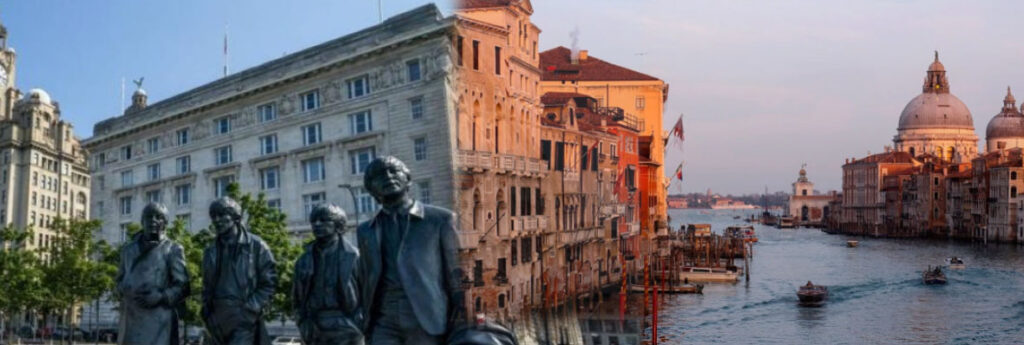There is fury across the Mersey this week as civic leaders in Liverpool express outrage that the English port city has been stripped of its World Heritage status by the United Nations’ culture organization. UNESCO’s World Heritage Committee voted in a secret ballot to remove the designation because of developments in the city centre and on its historic River Mersey waterfront, memorialized in the Gerry and the Pacemakers song “Ferry Across the Mersey.”
The committee said the projects, including a planned new stadium for soccer team Everton, were “detrimental to the site’s authenticity and integrity” and had caused “irreversible loss of attributes.”
Liverpool Mayor Joanne Anderson called the decision “incomprehensible,” adding that the UNESCO decisions “comes a decade after UNESCO last visited the city to see it with their own eyes.”
Anderson said the city would explore whether it could appeal, “but, whatever happens, Liverpool will always be a World Heritage city. We have a stunning waterfront and incredible built heritage that is the envy of other cities.”
The city’s waterfront was one of 32 UNESCO sites in Britain and an important designation that helped attract tourists, along with its status a birthplace of The Beatles, and home to Liverpool FC, one of the world’s most famous football teams.
Liverpool was one of the world’s busiest ports in the 18th and 19th centuries, growing prosperous from trade in goods and — until the trade in humans outlawed by Britain in 1807 — slaves. The docks declined and became derelict in the 20th century, but have been restored with museums, shops, bars, restaurants, and new housing developments, making Liverpool a symbol of urban renewal.
The city was added to UNESCO’s World Heritage list in 2004, joining sites including India’s Taj Mahal, Egypt’s pyramids and the Tower of London. But it was placed on the organization’s heritage in danger list in 2012 amid concerns that modern development was marring the docklands’ historic character.
The World Heritage Committee, made up of representatives from 21 countries, was asked to decide Liverpool’s fate after an experts’ report said “inadequate governance processes, mechanisms, and regulations for new developments in and around the World Heritage property” resulted in “serious deterioration and irreversible loss of attributes.”
Steve Rotheram, mayor of the wider Liverpool region, said the decision was “a retrograde step that does not reflect the reality of what is happening on the ground.”
“Many of the sites cited by UNESCO are in communities sorely in need of investment,” he said. “Places like Liverpool should not be faced with the binary choice between maintaining heritage status or regenerating left-behind communities — and the wealth of jobs and opportunities that come with it.”
“Our commitment to maintaining and improving our buildings remains as strong as ever and will continue to be a key part of our drive to attract visitors, along with leisure, retail and events.”
Speaking specifically about Everton’s stadium plan, Mayor Anderson said: “I find it incomprehensible that UNESCO would rather Bramley Moore Dock remain a derelict wasteland, rather than making a positive contribution to the city’s future and that of its residents.”
Venice
Meanwhile, Venice avoided a similar to fate to Liverpool’s in 2012 when UNESCO voted yesterday (July 22) not to place the city on its list of world heritage sites in danger.
The committee, meeting in China, instead asked Italy to submit by December an update on efforts to protect Venice from excessive tourism, population decline, and other issues that will be considered at a meeting in 2023.
The Italian government moved this month to avoid the danger designation, pledging to reroute massive cruise ships starting Aug. 1 from the city’s historic centre to an industrial port still within the Venice lagoon.
The ships’ passage through St. Mark’s Basin and the Giudecca Canal, which resumed recently after a long pandemic pause, was among the reasons UNESCO had cited for listing Venice’s status as at risk.
Italian Culture Minister Dario Franceschini welcomed UNESCO’s decision, stating, “Now, the global attention on Venice must remain high, and it is everyone’s duty to work for the protection of the lagoon and identify a sustainable development path for this unique reality.”
UNESCO’s World Heritage Center recommended last month adding Venice to the endangered list as a way to alert the international community to the urgency of the city’s situation. The centre’s director, Mechtild Roessler, says the designation is intended to foster a response that will help protect important at-risk sites in danger and resolve issues.
Still, such a designation is widely viewed as a rebuke of the local management of World Heritage sites, places that UNESCO recognizes for their outstanding universal value to humanity.

